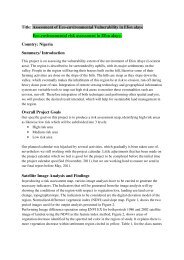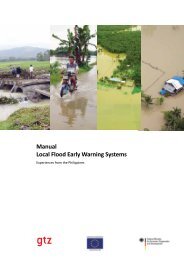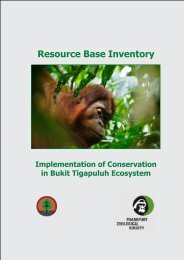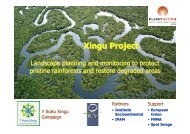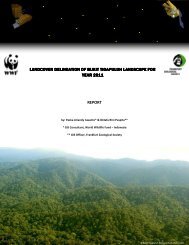The Eastern Himalayas New Species Discoveries
The Eastern Himalayas New Species Discoveries
The Eastern Himalayas New Species Discoveries
Create successful ePaper yourself
Turn your PDF publications into a flip-book with our unique Google optimized e-Paper software.
<strong>The</strong> <strong>Eastern</strong> <strong>Himalayas</strong> is at the crossroads of two continental plates<br />
represented by two biogeographical realms: the lowland Indo-Malayan Realm<br />
and to the north, the elevated Palearctic Realm. <strong>The</strong> meeting of these worlds<br />
has created one of the biologically richest areas on Earth.<br />
Spanning Bhutan, the north-eastern Indian states of Arunachal Pradesh, Assam, North Bengal<br />
and Sikkim, the far north of Myanmar (Burma), Nepal and southern parts of Tibet, the region<br />
includes four Global 200 ecoregions with their critical landscapes of international biological<br />
importance. <strong>The</strong> <strong>Himalayas</strong> are home to an estimated 10,000 plant species, 300 mammal<br />
species, 977 bird species, 176 reptiles, 105 amphibians and 269 freshwater fish. <strong>The</strong> region<br />
supports high density of the Bengal tiger and is the last bastion for the charismatic greater<br />
one-horned rhinoceros.<br />
Even today the rugged, and largely inaccessible landscape of the <strong>Eastern</strong> <strong>Himalayas</strong>, hides the<br />
real extent of the region’s biodiversity, with extraordinary new species continuing to be<br />
discovered year-on-year. Between 1998 and 2008, at least 353 new species have been<br />
discovered in the <strong>Eastern</strong> <strong>Himalayas</strong>, 35 new species finds on average every year for the last<br />
10 years (see Appendix).<br />
Many of WWF’s established priority conservation landscapes are being impacted by the<br />
current unsustainable development in the <strong>Eastern</strong> <strong>Himalayas</strong>, and so we consider that a new<br />
layer of strategic action is needed to augment our longstanding field projects. This includes<br />
asking the governments of Bhutan, India and Nepal to commit to a shared tripartite vision that<br />
recognises the global significance of the region and supports the implementation of a unified<br />
conservation and sustainable development plan that ensures the landscapes within the <strong>Eastern</strong><br />
<strong>Himalayas</strong> are connected.<br />
By promoting a shared sustainable development vision, WWF believes that real progress can<br />
be made in tackling huge poverty-impacting issues in the <strong>Eastern</strong> <strong>Himalayas</strong> such as climate<br />
change, deforestation, the illegal wildlife and timber trade, poor infrastructure development,<br />
and thereby secure the livelihoods, subsistence and fresh water essential to millions of people<br />
throughout the region.<br />
Only a concerted focus and a shared vision can maintain a living <strong>Himalayas</strong>, for people and<br />
nature, whether discovered or yet to be discovered.<br />
<strong>The</strong> extent of the new species finds place the <strong>Eastern</strong> <strong>Himalayas</strong> on a par with more wellknown<br />
biological hotspots such as Borneo.<br />
This report celebrates these unique and fascinating species discoveries. It also highlights<br />
growing pressures on the ecosystems and species as a consequence of unsustainable<br />
development in the region. Despite protection efforts, in the last half-century, this area of<br />
South Asia has faced a wave of pressures as a result of population growth and the increasing<br />
demand for commodities by global and regional markets. <strong>The</strong> host of threats include forest<br />
destruction as a result of unsustainable and illegal logging, agriculture, unsustainable fuel<br />
wood collection, overgrazing by domestic livestock, illegal poaching and wildlife trade,<br />
mining, pollution, hydropower development, and poorly planned infrastructure. <strong>The</strong> region is<br />
also among the most vulnerable to global climate change, which will amplify the impacts of<br />
these threats.<br />
Only 25% of the original habitats in the region remain intact and 163 species that live in the<br />
<strong>Eastern</strong> <strong>Himalayas</strong> are considered globally threatened.<br />
© Murat Selam<br />
Above: Where worlds collide. <strong>The</strong> <strong>Eastern</strong><br />
<strong>Himalayas</strong> is at the crossroads of two continental<br />
plates, creating one of the biologically richest<br />
areas on Earth.<br />
2





